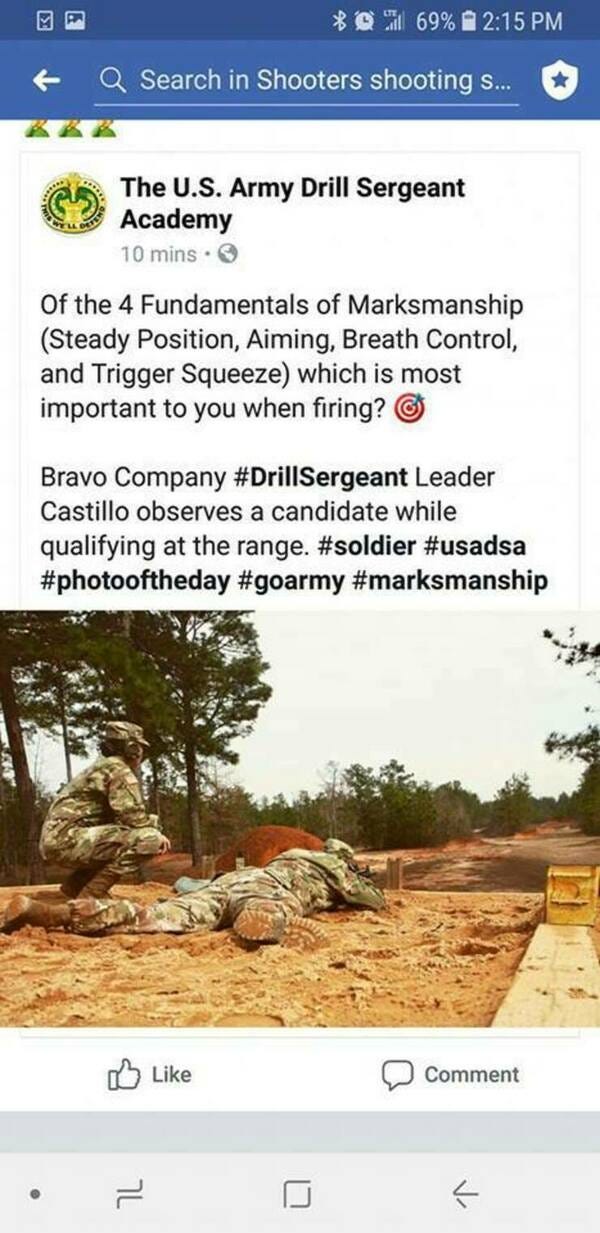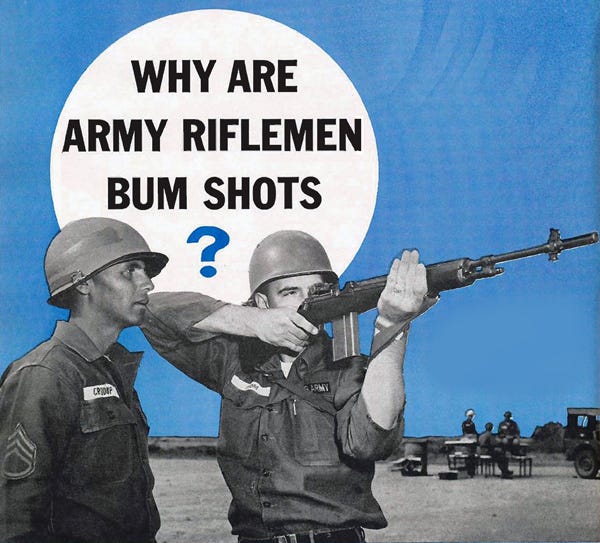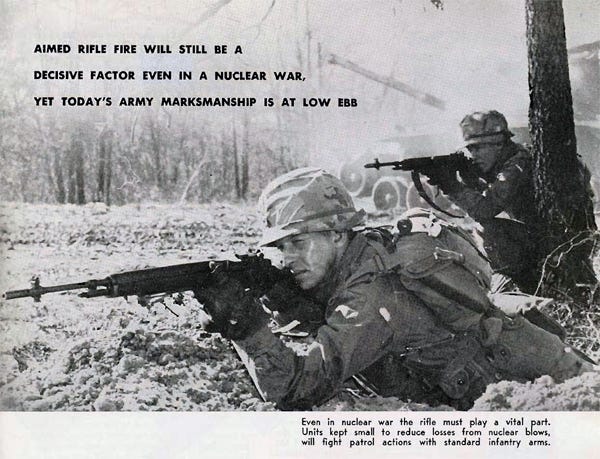TL;DR/BLUF: “Any NCO with the FM” is a failed training approach not used anywhere, except marksmanship for some bizarre reason. Army leadership does nothing to incentivize any change for the better. True in 1962, still true today.
The Army Research Institute published a report a few years ago finding that “a common theme identified was that many drill sergeants misunderstood parts of rifle marksmanship doctrine and/or inconsistently applied training techniques and procedures”.
Every published report on this confirms the same. Military leadership has this info available in the public domain and either remains ignorant (willfully?) or just disregards it. One of my elected representatives is on the Senate Armed Forces Committee and I contacted him about this. To my surprise, one of his aides returned my call but said (paraphrasing), “None of this is even on our radar.”
The Army Combat Fitness Test continues to receive Congressional attention because many Soldiers contacted their elected representatives to complain. However, there are no real career implications for failing small arms qualifications nor for failing to implement them to standard. Most military personnel are not shooters and don’t know what good shooting looks like. “Any NCO with the FM” can “teach” marksmanship, yet there is no mechanism in place to check if that NCO even read the manual, much less understands it.
Drill sergeants misapply or are unaware of the standard and “teach” marksmanship to about 72,000 Army recruits annually. This was revealed when the Army’s Training Circulars were released starting in 2016 as it took many senior leaders several years later to acknowledge that the doctrine had even changed. The Drill Sergeant Academy inadvertently publically revealed they were still unaware of the change over three years later. They changed the text of this post and deleted the comments pointing out their error. Anticipating they would do that, I took a screen capture of the original. The fact this sort of oversight has not been a widely acknowledged embarrassment is further proof of how broken the Army’s attempts at marksmanship is.
Even if military personnel could execute to standard, a shooter scoring a perfect qualification will likely have to triple that (or more) to work up to good competition shooting scores. This was the thesis of my book, Beyond Expert.
Until enough military leadership becomes aware of this and chooses to do something, this will remain the norm. As good as the current doctrine is, its implementation will only be as good as leadership’s and training personnel’s willingness to read and heed what has been published. This has been the case for nearly a century.
Why Are Army Riflemen Bum Shots?
by Col. Charles Askins (May 1962)
The army has artillery schools, tank schools, parachute schools, and schools in communications. It holds classes in driving, classes in baking, typing, cryptography, languages, explosives disposal, guerrilla warfare, and auto maintenance. But does the army have a school where it trains the soldier to be a marksmanship instructor? It does not, certainly nothing mandatory. Every man in the army today is armed. All are expected to fight. But the training in marksmanship is not supported by an army-wide school anywhere.
Marksmanship is taught by NCOs who are supposed to know their stuff through long years of service. These veterans stand up before their troops and tell them how it wants to be done. Then the recruits are paired up, and one acts as the coach while the other practices as the firer. After some drill in this manner, the two switch jobs and one becomes the marksman while the other serves as coach. Maybe in theory this is all right, but observation indicates it is not so good.
In the first place, the sergeant-instructor all too often does not know his stuff. It is true that maybe he has a dozen years in the army, but he was never taught properly in the beginning. He was not bundled off to a school of marksmanship and thus given a solid grounding before he commenced to instruct others. All he knows is what he picked out of the manual plus his all too brief annual qualification firing. Too, the chances are awfully good that he has no real interest in shooting and, as a result, his instruction is perfunctory indeed. His disinterest is soon apparent to his charges, and they promptly assume a similar don’t give-a-hang attitude.
Right here is where the lack of motivation plays such a critical part in the failure to make acceptable marksmen out of our recruit soldiers.
The army hands out marksmanship medals - expert, sharpshooter, and marksman awards. These, all too frequently, are not presented during a unit formation with all the formalities which are dear to the military heart. They are passed out by the company clerk, and the recipient dumps them in his foot locker and forgets ‘em. No one gazes with any particular respect on the soldier who wears the expert qualification badge. As a result, the shooting award falls flat.
The records show that the last time the army really shot well was pre-WW2. That was in the halcyon days when the common dogface drew down the handsome sum of thirty bucks monthly and was paid a few additional dollars if he could qualify with the old Springfield. The soldier today laughs at the little badges dished out for marksmanship. He would not, you may be sure, evince the same attitude if straight shooting was put on a paying basis. The army, today, has a proficiency pay system. Specialists who hold down key jobs are given extra pay. This incentive system should be expanded to include marksmanship. It worked before, and it would provide the incentive today to a sharpening up of the skill of our soldier marksman.
Col. Charles Askins, Jr. was an American lawman, U.S. Army officer, and writer. He served in law enforcement (U.S. Forest Service and Border Patrol) in the American Southwest prior to the Second World War. Askins was the son of Major Charles Askins, a sports writer and Army officer who served in the Spanish–American War and World War I.
Askins was recruited by the U.S. Border Patrol in 1930. During his service the there, Askins won many pistol championships, and was made the leader of the Border Patrol’s handgun skills program. Askins served in the U.S. Army during World War II as a battlefield recovery officer, making landings in North Africa, Italy, and on D-Day. After World War II, he spent several years in Spain as an attache to the American embassy there, helping Franco rebuild Spain’s munition plants. He held several big game hunting records in his lifetime, as well as two national pistol championships, an American Handgunner of the Year award, and innumerable smaller titles in competitive shooting. Askins, like his father, was a prolific writer, writing books and over 1,000 magazine articles on subjects related to hunting and shooting. His writing career spanned 70 years, from 1929 until his death in 1999.








When I was in during The Jurassic Period, rifle marksmanship was in a dismal state. I qualified in Basic, and never qualified again during my enlistment of 3 years. Later in life, I participated in NRA Service Rifle Matches and discovered that the Army had not taught me to shoot a rifle; they had taught me how to operate a rifle. Plus, whenbudgets get tight, the first thing X-ed out is ammo. After all, if a soldier gets injured on the range, that could be the end of an officer's career.
Not everyone was blind to the problem.
https://smallwarsjournal.com/blog/journal/docs-temp/532-wall.pdf